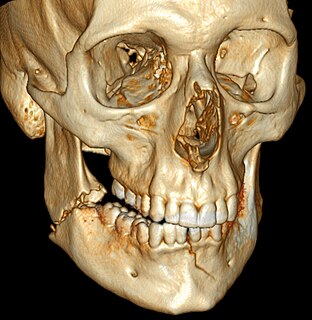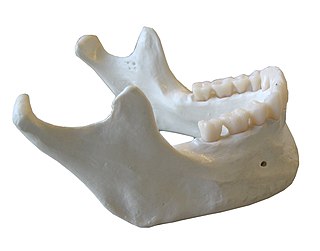Related Research Articles

Temporomandibular joint dysfunction is an umbrella term covering pain and dysfunction of the muscles of mastication and the temporomandibular joints. The most important feature is pain, followed by restricted mandibular movement, and noises from the temporomandibular joints (TMJ) during jaw movement. Although TMD is not life-threatening, it can be detrimental to quality of life; this is because the symptoms can become chronic and difficult to manage.

In anatomy, the temporomandibular joints (TMJ) are the two joints connecting the jawbone to the skull. It is a bilateral synovial articulation between the temporal bone of the skull above and the mandible below; it is from these bones that its name is derived. This joint is unique in that it is a bilateral joint that functions as one unit. Since the TMJ is connected to the mandible, the right and left joints must function together and therefore are not independent of each other.
Prosthodontics, also known as dental prosthetics or prosthetic dentistry, is the area of dentistry that focuses on dental prostheses. It is one of 12 dental specialties recognized by the American Dental Association (ADA), Royal College of Surgeons of England, Royal College of Surgeons of Edinburgh, Royal College of Surgeons of Ireland, Royal College of Surgeons of Glasgow, Royal College of Dentists of Canada, and Royal Australasian College of Dental Surgeons. The ADA defines it as "the dental specialty pertaining to the diagnosis, treatment planning, rehabilitation and maintenance of the oral function, comfort, appearance and health of patients with clinical conditions associated with missing or deficient teeth or oral and maxillofacial tissues using biocompatible substitutes."

The lateral pterygoid muscle (or external pterygoid muscle) is a muscle of mastication. It has two heads. It lies superior to the medial pterygoid muscle. It is supplied by pterygoid branches of the maxillary artery, and the lateral pterygoid nerve (from the mandibular nerve, CN V3). It depresses and protrudes the mandible. When each muscle works independently, they can move the mandible side to side.

The condyloid process or condylar process is the process on the human mandible and some other species' mandibles that ends in a condyle, the mandibular condyle. It is thicker than the coronoid process of the mandible and consists of two portions: the condyle and the constricted portion which supports it, the neck.

The squamous part of temporal bone, or temporal squama, forms the front and upper part of the temporal bone, and is scale-like, thin, and translucent.

An articulator is a mechanical hinged device used in dentistry to which plaster casts of the maxillary (upper) and mandibular (lower) jaw are fixed, reproducing some or all the movements of the mandible in relation to the maxilla. The human maxilla is fixed and the scope of movement of the mandible is dictated by the position and movements of the bilateral temperomandibular joints, which sit in the glenoid fossae in the base of the skull. The temperomandibular joints are not a simple hinge but rotate and translate forward when the mouth is opened.

The articular disk of the temporomandibular joint is a thin, oval plate made of non-vascular fibrous connective tissue, which is located between the mandible's condyloid process and the cranium's mandibular fossa.
Occlusion, in a dental context, means simply the contact between teeth. More technically, it is the relationship between the maxillary (upper) and mandibular (lower) teeth when they approach each other, as occurs during chewing or at rest.

In dentistry, maximum intercuspation refers to the occlusal position of the mandible in which the cusps of the teeth of both arches fully interpose themselves with the cusps of the teeth of the opposing arch. This position used to be referred to as centric occlusion.

Vertical dimension of occlusion, or VDO, also known as occlusal vertical dimension (OVD), is a term used in dentistry to indicate the superior-inferior relationship of the maxilla and the mandible when the teeth are occluded in maximum intercuspation.

Crossbite is a form of malocclusion where a tooth has a more buccal or lingual position than its corresponding antagonist tooth in the upper or lower dental arch. In other words, crossbite is a lateral misalignment of the dental arches.

Mandibular fracture, also known as fracture of the jaw, is a break through the mandibular bone. In about 60% of cases the break occurs in two places. It may result in a decreased ability to fully open the mouth. Often the teeth will not feel properly aligned or there may be bleeding of the gums. Mandibular fractures occur most commonly among males in their 30s.

Dislocations occur when two bones that originally met at the joint detach. Dislocations should not be confused with Subluxation. Subluxation is when the joint is still partially attached to the bone.

In anatomy, the mandible, lower jaw or jawbone is the largest, strongest and lowest bone in the human facial skeleton. It forms the lower jaw and holds the lower teeth in place. The mandible sits beneath the maxilla. It is the only movable bone of the skull. It is connected to the temporal bones by the temporomandibular joints.

Condylar resorption, also called idiopathic condylar resorption, ICR, and condylysis, is a temporomandibular joint disorder in which one or both of the mandibular condyles are broken down in a bone resorption process. This disorder is nine times more likely to be present in females than males, and is more common among teenagers.

A face-bow is a dental instrument used in the field of prosthodontics. Its purpose is to transfer functional and aesthetic components from patient's mouth to the dental articulator. Specifically, it transfers the relationship of maxillary arch and temporomandibular joint to the casts. It records the upper model's (maxilla) relationship to the External Acoustic Meatus, in the hinge axis. It aids in mounting maxillary cast on the articulator.
A complete denture is a removable appliance used when all teeth within a jaw have been lost and need to be prosthetically replaced. In contrast to a partial denture, a complete denture is constructed when there are no more teeth left in an arch, hence it is an exclusively tissue-supported prosthesis. A complete denture can be opposed by natural dentition, a partial or complete denture, fixed appliances or, sometimes, soft tissues.

Posselt's envelope of motion or Posselt's envelope of movement refers to the range of motion of the lower jaw bone, or mandible.
Occlusion according to The Glossary of Prosthodontic Terms Ninth Edition is defined as 'the static relationship between the incising or masticating surfaces of the maxillary or mandibular teeth or tooth analogues'.
References
- ↑ Nallaswamy, Deepak (2011). Textbook of Prosthodontics. Jaypee. p. 844. ISBN 81-8061-199-X.
- Davis Henderson, Victor L. Steffel. McCracken's Removable partial prosthodontics, 4th Edition, 1973.